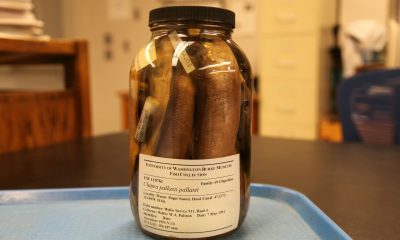Too much napping for retirees could be worrying warning sign of dementia
Fast increases in the amount of naps someone takes could be a sign their memory problems are deteriorating quickly.
Published
2 years ago onBy
Talker News
By Gwyn Wright via SWNS
Napping too much in the day as you get older could be a worrying warning sign of dementia, according to a new study.
Researchers have found a "vicious cycle" between excessive daytime napping among the elderly, Alzheimer’s and dementia.
A team of academics in the US have found napping too much in the day raised retirees' risk of Alzheimer’s and dementia while both conditions also caused old people to take more naps during the daytime.
The researchers say old people’s sleeping patterns are not well understood by experts and the link between naps and both diseases had previously been unknown.
Fast increases in the amount of naps someone takes could be a sign their memory problems are deteriorating quickly.
The findings call for more attention to be paid to daytime sleeping patterns so the links can be better understood, the researchers add.
Previous studies on links between naps and dementia have had mixed results, with some even saying a nap slows down the brain’s deterioration.
However, the team say these studies were not accurate because they were based on questionnaires and assessed napping with a participant only once.
For the new study, the scientists looked at data from 1,401 people with an average age of 81.
Around three quarters of participants were women and participants were followed up for up to 14 years.
They were given a watch-like device which they wore on their non-dominant wrist for two weeks every year.
Each year they undertook a range of tests to assess their cognitive skills.
The team identified sleep episodes using a sleep-scoring algorithm that considers wrist activity counts.
It calculated the length of each nap and the frequency of snoozes.
Any long period of non-activity between 9 A.M. and 7 P.M. was counted as a nap.
When the study began, 75.7 percent of participants had no cognitive impairment, while 19.5 percent of them had mild cognitive impairment and 4.1 percent had Alzheimer’s disease.
For participants who did not develop cognitive impairment, daily daytime napping increased by an average 11 minutes per year.
The rate of increase doubled after a diagnosis of mild cognitive impairment to 24 minutes and nearly tripled to 68 minutes after a diagnosis of Alzheimer’s disease.
When the team looked at the 24 percent of participants who had normal cognition at the start of the study but developed Alzheimer’s six years later and compared them with those whose cognition remained stable, they found differences in napping habits.
Participants who napped for more than an hour a day had a 40 percent higher risk of developing Alzheimer’s than those who napped less than an hour a day.
In addition, participants who napped at least once a day had a 40 pe cent higher risk of developing Alzheimer’s than those who napped less than once a day.
The length and frequency of naps grew as the diseases progressed, particularly after a diagnosis.
The findings build on work by one of the study’s authors which found older men who napped two hours a day were more likely to develop cognitive impairment that those who napped less than 30 minutes a day.
This study builds on these findings by evaluating both daytime napping and cognition once a year.
The findings held up independently of known risk factors for Alzheimer’s and dementia such as age and the length and frequency of sleeps.
The researchers believe the fact people with Alzheimer’s have fewer neurons in their brain telling them to stay awake may explain the results.
First author Dr Peng Li said: “Daytime sleep behaviors of older adults are oftentimes ignored, and a consensus for daytime napping in clinical practice and health care is still lacking.
“Our results not only suggest that excessive daytime napping may signal an elevated risk of Alzheimer’s dementia, but they also show that faster yearly increase in daytime napping may be a sign of deteriorating or unfavoured clinical progression of the disease.
“Our study calls for a closer attention to 24-hour sleep patterns, not only night-time sleep but also daytime sleep, for health monitoring in older adults.
“The vicious cycle we observed between daytime sleep and Alzheimer’s disease offers a basis for better understanding the role of sleep in the development and progression of Alzheimer’s disease in older adults.”
Senior co-author Dr. Kun Hu said: “Our hope is to draw more attention to daytime sleep patterns and the importance of patients noting if their sleep schedule is changing over time.
“Sleep changes are critical in shaping the internal changes in the brain related to the circadian clocks, cognitive decline and the risk of dementia.”
Senior co-author Dr. Yue Leng said: ““We found the association between excessive daytime napping and dementia remained after adjusting for night-time quantity and quality of sleep.
“This suggested that the role of daytime napping is important itself and is independent of night-time sleep.
“The study shows for the first time that napping and Alzheimer’s disease seem to be driving each other’s changes in a bi-directional way.
“I don’t think we have enough evidence to draw conclusions about a causal relationship, that it’s the napping itself that caused cognitive aging, but excessive daytime napping might be a signal of accelerated aging or cognitive aging process.
“It would be very interesting for future studies to explore whether intervention of naps may help slow down age-related cognitive decline.”
The study was a collaboration between Brigham and Women’s Hospital in Boston, the Rush Alzheimer’s Disease Center in Chicago and the University of California, San Francisco.
The findings were published in Alzheimer’s and Dementia: The Journal of the Alzheimer’s Association.
Stories and infographics by ‘Talker Research’ are available to download & ready to use. Stories and videos by ‘Talker News’ are managed by SWNS. To license content for editorial or commercial use and to see the full scope of SWNS content, please email [email protected] or submit an inquiry via our contact form.
You may like


How blood samples will be able to tell whether cancer patients will survive


Stroke deaths rising after plummeting for 40 years


New artificial pancreas could help Type 2 diabetes patients


How algae can help wounds heal quicker


Antibiotic residue in wastewater contributing to dangerous resistance


Warming oceans decimated sea parasites to damage environment
Other Stories


Scientists launching spaceship that could help us sail to Mars
The NASA mission will test a new way of navigating our solar system.


Disabled student takes first steps in 10 years on graduation stage
"It was a big success."


Helmet Formula 1 legend Niki Lauda wore in infamous crash up for auction
Niki Lauda was lucky to survive his burning car in the 1976 incident at Germany's Nurburgring.


Majority of parents ‘customize’ meals for picky kids
Only 15% of parents say their family rule is that kids finish what’s on their plate.


Scientists estimate as much as 11M tons of plastic sitting on ocean floor
Researchers predicted how much plastic pollution ends up on the ocean floor.
Top Talkers

 Parenting5 days ago
Parenting5 days agoSingle mom details struggles of feeding her 12 kids

 Lifestyle4 days ago
Lifestyle4 days agoWoman regrets her tattoo nightmare: ‘It’s horrendous’

 Broadcast7 days ago
Broadcast7 days agoOver 40% of Americans have no clue what a 401k is

 Broadcast6 days ago
Broadcast6 days agoHow hard is it for Americans to live sustainably?

 Money7 days ago
Money7 days agoOver 40% of Americans have no clue what a 401k is

 Pets1 week ago
Pets1 week agoMost cat owners know very little about their feline friends

 Environment6 days ago
Environment6 days agoHow hard is it for Americans to live sustainably?

 Health1 week ago
Health1 week agoDoctors find new use for Barbie dolls in online appointments
